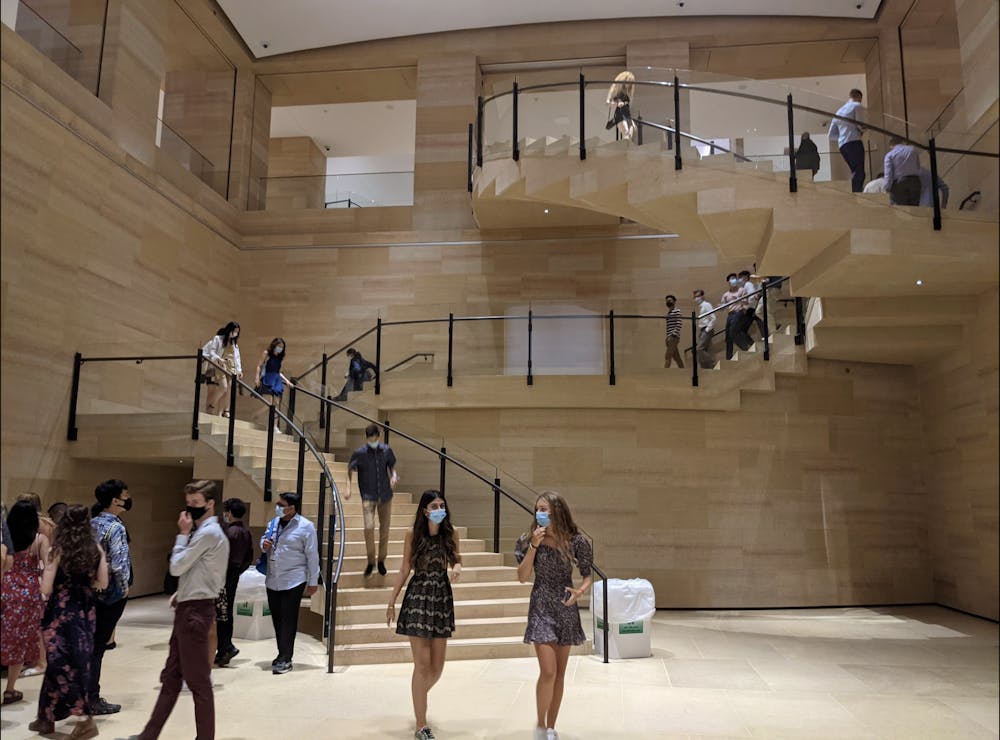Just days after move–in, bright–eyed sophomores took buses up to Fairmount Hill to enjoy art, refreshments, and each other’s company. In the historic Philadelphia Museum of Art, second–year Penn students schmoozed and chit chatted, ushering in what will hopefully be a more community–driven year at Penn. It was a celebration of togetherness for the Class of 2024, marking the first time all of us have been together in one place. The Philadelphia Museum of Art, which Penn rented out in its entirety, made for a special and memorable gala venue because of its scale and landmark status.
After four years of construction spearheaded by Frank Gehry, the museum fully reopened in May—making it an even more apt location for the sophomore class to gather at the start of the year. The space’s grand ceilings and Greek revival architecture elicited oohhs and aahhs from the guests. Plus, it proved a great conversation starter for sophomores as we finally started to get acquainted with one another.
“I think it’s really special that Penn was able to do this for us because it’s a really unique and unusual place,” says Hudson Vance (C '24). “We appreciate that Penn went to extraordinary lengths to get such a grand and spectacular venue to introduce us into our sophomore year.”
Much like how the gala honors a long–standing tradition at Penn, the $233 million renovation and extension of the Beaux–Artes style museum was intended to honor and highlight the building’s historic originality. Frank Gehry’s boundary–pushing architectural designs are likely what earned him awards like the Pritzker Prize; yet for this undertaking, called the Core Project, he focused more on improving the existing structure and design rather than redoing it. "The goal in all of our work at the Philadelphia Museum of Art has been to let the museum guide our hand," says Gehry.
As for the museum’s transformation, the stone walls throughout the building were deep cleaned and new LED lights were installed into the vaulted ceilings. Both were intended to guide visitors as they weave through the museum halls, and to give the space a sparkling, uplifting glow. Returning to a small town in southern Minnesota, just like the original architects Horace Trumbauer and Julian Abele did in the early 20th century, Gehry sourced a rare type of golden limestone called Kasota stone for the design.

Furthermore, after nearly 50 years of closure, the 640–foot–long Vaulted Walkway was restored and updated—allowing visitors to view the museum from a new angle by wandering around its perimeter. The reopening was part of Gehry’s effort to highlight the history of the space, creatively bringing the past back into the present and reviving a centuries–old experience for museum–goers. The corridor also has new Guastavino tiles decorating its vaults as well as improved infrastructure including pipes and cables. It leads to a recently updated area called the South Hall which now houses a variety of sculptures.
Perhaps the most monumental change by Gehry was the Williams Forum, which is a brand new, grand–scale installation area that took the place of the old auditorium. During the gala, mask–clad students danced to the Top 40 hits booming out of the DJ’s speakers, which echoed around the massive space. Theatrically curved, pristine limestone staircases with bronze railings lead visitors down to the 40–foot–high space, connecting the primary entrance and central staircases—thereby improving the museum’s flow. “He knows the way buildings work and how to organize sequences of spaces,” says museum director Timothy Rub. “That’s exactly what we needed in a building as big and as complicated as ours.”

Gehry ultimately added 90,000 square feet to the building, and redesignated 20,000 square feet to include offices, a restaurant, and storage. This expansion gave more room “for art and for people,” just as Gehry said was his goal. The Daniel W. Dietrich II Galleries give more room for modern and contemporary art at the museum. The new Robert L. McNeil, Jr. Galleries are now centered around Early American Art with a Philadelphia focus, paying close attention to the contributions of Black, Latin American, and Indigenous artists at the time. The gallery hopes to offer a refreshing perspective on the past that confronts the erasure of non–white individuals in American art history.
The museum created an aura of sophistication and grandeur for the students, emanating from its historic and impressive architecture. "It’s really fun to just wander around the gallery and see what art speaks to you,” says Erin Schott (C '24). While the highbrow gala experience may be once in a lifetime, the museum is there to stay. It beckons visitors from the sophomore class and far beyond to not only view the art it holds, but to appreciate its old and new architecture. The newest iteration of the museum is almost as much of a masterpiece as the art inside it.







